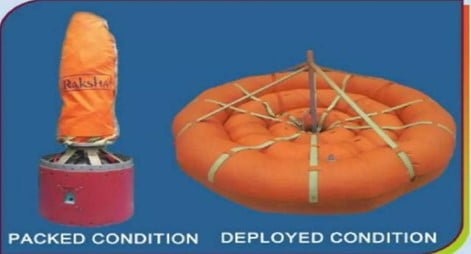Science and Technology
In News: The Indian Space Research Organisation (ISRO) just declared that it has successfully demonstrated the new technology with Inflatable Aerodynamic Decelerator (IAD).
What is IAD?
- IAD is a technique used for an atmospheric entry payload.
- An inflatable envelope and an inflatant (anything that inflates the envelope, like air or helium) make up the inflatable aerodynamic decelerator.
- While entering the atmosphere, it inflates like a balloon and decelerates the lander.
- The inflatant is designed to fill the inflatable envelope to a condition such that it surrounds the payload meant to enter the atmosphere of a planet or satellite and causes aerodynamic forces to slow it down.
- In simpler words, IAD is designed to increase drag upon entering the atmosphere of any planetary body, like Earth, Mars, or even Moon.
- Its shape is maintained by a closed, gas-pressured body and the inflatant gas is also generated internally. Some versions also use ram air or both.
- Some space agencies, including NASA, have already successfully tested advanced versions of the technology, including the supersonic and hypersonic variants.
- However, for near future missions of ISRO, the current version that it tested is perfect.

ISRO’s IAD
- ISRO’s latest IAD has been designed and developed at Vikram Sarabhai Space Centre.
- It also has a spin rocket that is ejectable.
- The inflatable structure is made out of Kevlar fabric, which is a very strong synthetic fibre and also heat resistant to withstand atmospheric pressure and temperature changes.
- On top of it, it’s coated with polychloroprene, an oil and wax resistant rubber, which can also withstand extreme temperatures.
- The Liquid Propulsion Systems Centre (LPSC), created the pneumatic inflation system for the IAD system.
- In the inflation system, it uses compressed nitrogen stored in a bottle.
- It has consistently decreased the payload’s velocity through aerodynamic drag while maintaining the expected trajectory during the test flight.
Where does ISRO intend to use it?
- The IAD will help ISRO in performing many space tasks effectively including recovery of spent stages of rockets, for landing payloads on missions to other planetary bodies.
Source: The Hindu
Previous Year Question
1) Which one of the following statements best reflects the idea behind the “Fractional Orbital Bombardment System” often talked about in media ?
- A hypersonic missile is launched into space to counter the asteroid approaching the Earth and explode it in space.
- A spacecraft lands on another planet, after making several orbital motions.
- A missile is put into a stable orbit around the Earth and deorbits over a target on the Earth.
- A spacecraft moves along a comet with the same speed and places a probe on its surface.













